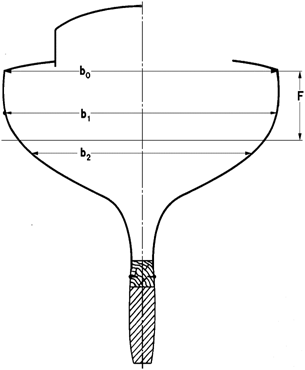An outline of the Square Metre Rule
Introduction to the Square Metre Rule
Rules for Skerry Cruisers (Square Metre Rule), edition 2005/1 (PDF 501 KB)
The idea of the Square Metre rule when it was first adopted in 1908, was that the sail area should be fixed, allowing, the hull to be totally free for the designer to draw the best lines he could. Progressively, and especially during the early 1920´s the hulls became longer and more slender, much faster on inshore waters but less sea-worthy. For example, one of the last yachts to be designed to the old rule had dimensions of loa 13,40m, beam 1,75!!!
As interest in the class ceased when the yachts became more extreme and expensive to build, the rule was totally changed in 1925.
In the new rule the idea of the fixed sail area was preserved, but certain limits were applied to the hull design, as detailed below.
The Square Metre Rule of 1925 is, with small adjustments made over the years, still the current Square Metre Rule. It was devised by the Swedish professor of mechanics and materials, Karl Ljungberg, and included new scantlings based upon experience with the previous rule.
The Square Metre Rule of 1925 is based on a theoretical minimum yacht, thus the idea of a free hull is kept, except that if one wishes to make a larger hull, then one must increase four different measurements according to the proportions of the theoretical minimum yacht. These four measurements are: displacement, freeboard, length of keel and mean beam.
The length of the yacht (the Lx Line) is measured some centimetres above the waterline; for example, for a 30 sq metre yacht it is 18 cm, for a 22sq metre yacht it is 15 cm, and so on for all the nine different classes of the square metre yachts.
Here are some examples of different 30´s that you can build, remembering that they all have the same sail area.
| Yacht | Approximate length and beam for a normal yacht | Lx-line | displacement | freeboard medium | beam | length of keel |
|---|---|---|---|---|---|---|
| minimum | 11,70 m * 2,03 m | 9,10 m | 2000 kg | 50 cm | 186 cm | 230 cm |
| average | 12,50 m * 2,20 m | 10,30 m | 2563 kg | 55 cm | 198 cm | 260 cm |
| large | 13,85 m * 2,24 m | 10,80 m | 2817 kg | 57 cm | 203 cm | 273 cm |
|
 |

The large sails often surprise people as they appear to be lot larger than 30 (still for a 30 sq m) sq metres. The explanation is that the size and shape of the head sails and spinnakers are free, what is measured is only the fore-triangle of the rig, which is measured to 85%. The main sail is measured to its full area. The proportions between the mainsail and the fore-triangle are also unrestricted, thus it is possible to use very large genoas and spinnakers if desired.
The rule also includes other different measurements, such as a special formula to for the fore-body of the yacht in order to ensure a certain overhang at the bow. In addition, there are minimum measurements for the cabin that provide adequate accommodation space. The sq metre yachts, contrary to the R-yachts, are not open decked, but provides a minimum level of comfort. For the smaller classes such as the 22´s and the 30´s, it is only necessary to have a cabin of a certain minimum size and two sleeping berths.
As mentioned previously, there are nine sq metre classes, the 15, 22,30,40, 55, 75, 95, 120 and 150 class. The 22 and 30´s have been international classes, and the 30´s and 40´s have been Olympic classes. The larger yachts, that is larger than the 30´s, were mostly built before the 1925 rule, and are now mostly to be found in the Baltic where they are cared for by enthusiasts and carefully raced and sailed in the skerries as cruisers.
On the other hand the 22´s and the 30´s have shown great development and a larger number of new designs to the 1925 rule. New yachts are still being built every year. Last summer (2005) for example two new 22 sqm were launched. These two boats are both fibreglass constructions.
The 30´s are more widely spread and can be seen in Sweden, Germany, Austria, Switzerland, Hungary, Finland, England, Australia, South Africa as well as on the Great Lakes of North America.
Finally a short linguistic explanation. The word "Skerry Cruiser" is often used when speaking of the Square Metre Yachts. This is just a mistranslation of the Swedish word skärgårdskryssare (German Schärenkreuzer) which simply means a boat that is good at tacking in the skerry (=archipellago), and has nothing to do with the English word cruiser.